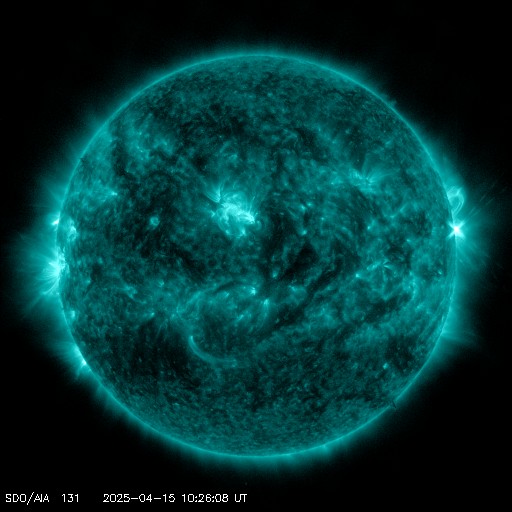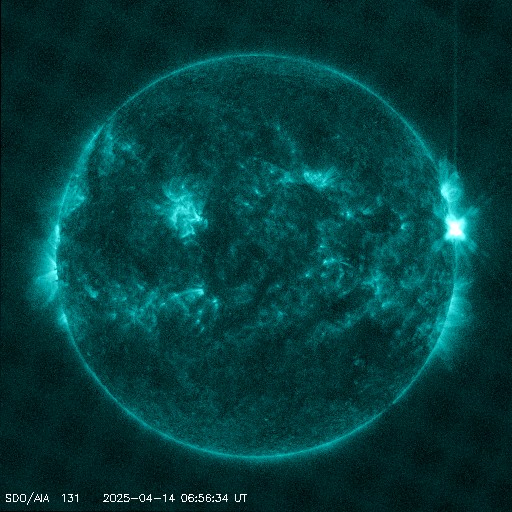Viewing archive of Sunday, 26 November 2000
Solar activity report
Any mentioned solar flare in this report has a scaling factor applied by the Space Weather Prediction Center (SWPC). Because of the SWPC scaling factor, solar flares are reported as 42% smaller than for the science quality data. The scaling factor has been removed from our archived solar flare data to reflect the true physical units.
Report of Solar-Geophysical Activity 2000 Nov 26 2200 UTCPrepared by the NOAA © SWPC and processed by SpaceWeatherLive.com
Joint USAF/NOAA Report of Solar and Geophysical Activity
SDF Number 331 Issued at 2200Z on 26 Nov 2000IA. Analysis of Solar Active Regions and Activity from 25-2100Z to 26-2100Z
Solar activity remained high. Region 9236 (N24W38)
produced an X4/2b at 26/1648 UTC. This flare included a Type II
radio sweep (1000 km/s estimated drift speed) and a 700 sfu radio
burst at 2695 MHz. This region also generated an M2/1f flare at
26/0308 UTC and several C-class subflares. The sunspot group remains
large and magnetically complex. Other disk regions were relatively
quiet.
IB. Solar Activity Forecast
Solar activity is expected to be high.
Region 9236 is capable of producing another major flare.
IIA. Geophysical Activity Summary 25-2100Z to 26-2100Z
The geomagnetic field ranged from quiet to minor storm levels. The
first of the expected CME's arrived at ACE at 26/0500 UTC. The
greater than 10 MeV proton event remains in progress. A new maximum
of 923 pfu was observed at 26/1955 UTC. The greater than 100 MeV
protons exceeded the event threshold at 26/1640 UTC and reached a
peak of 1.2 pfu at 26/1650 UTC. These particles have since dropped
below event level.
IIB. Geophysical Activity Forecast
The geomagnetic field is
expected to be at minor to major storm levels during the next 48
hours in response to the flare/CME activity of the last few days.
The greater than 10 MeV event is expected to remain in progress for
at least the next 24 hours. Another 100 MeV event is possible if
Region 9236 produces another significant flare.
III. Event Probabilities 27 Nov to 29 Nov
| Class M | 80% | 70% | 60% |
| Class X | 60% | 50% | 40% |
| Proton | 99% | 75% | 50% |
| PCAF | in progress | ||
IV. Penticton 10.7 cm Flux
Observed 26 Nov 202 Predicted 27 Nov-29 Nov 205/205/200 90 Day Mean 26 Nov 175
V. Geomagnetic A Indices
Observed Afr/Ap 25 Nov 004/007 Estimated Afr/Ap 26 Nov 020/025 Predicted Afr/Ap 27 Nov-29 Nov 050/060-030/045-020/025
VI. Geomagnetic Activity Probabilities 27 Nov to 29 Nov
| A. Middle Latitudes | |||
|---|---|---|---|
| Active | 05% | 20% | 40% |
| Minor storm | 40% | 20% | 10% |
| Major-severe storm | 50% | 30% | 05% |
| B. High Latitudes | |||
|---|---|---|---|
| Active | 10% | 20% | 50% |
| Minor storm | 30% | 40% | 10% |
| Major-severe storm | 60% | 35% | 05% |
All times in UTC
Latest news
Latest forum messages
2025/04/12-13 Filament CMEs 2025/04/16 G2 Watch 58AR4062 12Incoming & Unnumbered Active Regions 1710AR 4062 1Ask your obscure/"stupid" space weather questions. 355
More topicsSupport SpaceWeatherLive.com!
A lot of people come to SpaceWeatherLive to follow the Sun's activity or if there is aurora to be seen, but with more traffic comes higher server costs. Consider a donation if you enjoy SpaceWeatherLive so we can keep the website online!

Latest alerts
10:39 UTC - Solar flare
Moderate M1.52 flare from sunspot region 4055
10:24 UTC - Radio Blackout
Minor R1 radio blackout in progress (≥M1 - current: M1.52)
Monday, 14 April 2025
23:15 UTC - Geomagnetic activity
Active geomagnetic conditions (Kp4) Threshold Reached: 23:01 UTC
07:09 UTC - Solar flare
Moderate M4.28 flare from sunspot region 4055
06:48 UTC - Radio Blackout
Minor R1 radio blackout in progress (≥M1 - current: M1.53)
Space weather facts
| Last X-flare | 2025/03/28 | X1.1 |
| Last M-flare | 2025/04/14 | M4.2 |
| Last geomagnetic storm | 2025/04/06 | Kp5 (G1) |
| Spotless days | |
|---|---|
| Last spotless day | 2022/06/08 |
| Monthly mean Sunspot Number | |
|---|---|
| March 2025 | 134.2 -20.4 |
| April 2025 | 128.8 -5.4 |
| Last 30 days | 129.1 -15.1 |





